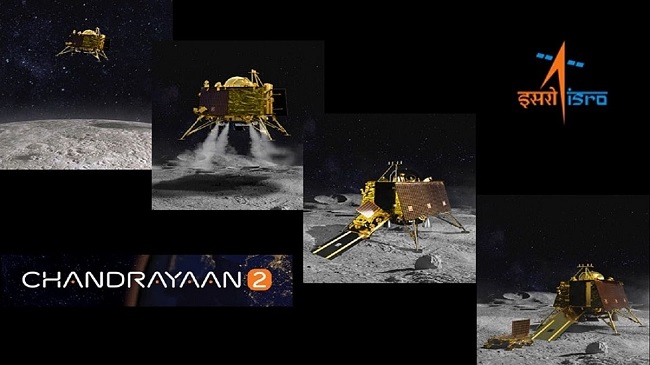ISRO Loses Contact With Vikram Lander During Final Descent to Lunar Surface

ISRO’s plan to soft land Chandrayaan-2’s Vikram module on the Lunar surface did not go as per script in the early hours of Saturday, with the lander losing communication with ground stations during its final descent. The “terrifying 15 minute” complex landing process, which commenced with a lot of expectation, tinged with a sense of jubilation was going on well till the successful rough braking phase which was marked by rounds of applause. When the top ISRO scientists including its chief Sivan looked glum soon after the subsequent fine braking phase commenced, it was the first indication that all was not well.Scientists led by Sivan went into a huddle and Prime Minister Narendra Modi, who was keenly tracking the progress was briefed on the development and a sombre mood enveloped the mission Operations Complex at ISRO Telemetry, Tracking and Command Network (ISTRAC), Bengaluru which quickly led to dejection; all in a span of about half an hour after the process began. Later, Sivan made the announcement that communication was lost with the lander, while PM Modi boosted the morale of the scientists asking them not to lose hope.
Vikram lander descent was as planned and normal performance was observed up to an altitude of 2.1 km. Subsequently, communication from the lander to ground stations was lost, ISRO Chairman K Sivan said, his voice choking. “The data is being analysed”, he added at the Mission Operations Complex at ISRO Telemetry, Tracking and command network (ISTRAC), Bengaluru as the disappointment was writ large on the faces of ISRO scientists. PM Modi, who flew into Bengaluru on Friday night to watch the planned touchdown of Vikram, told ISRO scientists not to get dejected and disheartened and said the country was proud of them.”I see disappointment on your faces. No need to get dejected. We have learnt a lot,” PM Modi said. “These are moments to be courageous, and courageous we will be! We remain hopeful and will continue working hard on our space programme”. ISRO later tweeted that the Prime Minister will address the nation from ISRO Control Centre on Saturday at 8 am.For ISRO the “15 minutes of terror” arrived as the powered descent of the lander began at around 1.38 am. “This is a very complex process and it is new for us….We are doing this for the first time, so it will be 15 minutes of terror for us,” Sivan had said earlier. Scientists at ISRO Telemetry Tracking and command network (ISTRAC), Bengaluru were glued to their terminals, anticipating the soft landing. It was then that the scientists started becoming tense and went into a huddle.
ISRO Chairman K Sivan was seen engaged in intense discussions with some scientists before announcing the disappointing news. Till the communication was snapped, the prime minister was found glued to the giant monitors which was tracking the descent. He was also listening keenly to some scientists who were explaining the nitty-gritty of the operation. The 1,471-kg ‘Vikram’, named after Dr Vikram A Sarabhai, father of the Indian space programme, was designed to execute a soft landing on the lunar surface, and to function for one lunar day, which is equivalent to about 14 earth days. The lander carried three scientific payloads to conduct surface and sub-surface science experiments.’Vikram’ was to perform a series of complex braking manoeuvres to soft land in the South polar region of the Moon between two craters, Manzinus C and Simpelius N, on Saturday. It successfully completed the rough braking phase but lost communication with the ground stations during the fine braking phase, according to ISRO. The rover Pragyan’, housed in Vikram, was to roll down from the lander explore the surrounding lunar terrain, a few hours after the planned soft-landing. The unmanned Chandrayaan-2 mission, a follow-on to the Chandrayaan-1 venture launched more than a decade ago, comprises an orbiter, lander (Vikram) and rover (Pragyan).
The mission life of the orbiter will be one year while that of the lander and rover was to be one lunar day which is equal to 14 earth days. A successful touchdown would have made India the fourth country after Russia, the US and China to achieve a soft landing on the moon and the first to launch a mission to the unexplored south polar region. The Chandrayaan-2 is a Rs 978 crore unmanned moon mission (satellite cost Rs 603 crore, GSLV MK III cost Rs 375crore). India’s Geosynchronous Satellite Launch Vehicle, GSLV MkIII-M1 successfully launched the 3,840-kg Chandrayaan-2 spacecraft into the Earth’s orbit on July 22.The spacecraft began its journey towards the moon leaving the earth’s orbit in the dark hours on August 14, after a crucial manoeuvre called Trans Lunar Insertion that was carried out by ISRO to place the spacecraft on “LunarTransfer Trajectory.” The spacecraft successfully entered the lunar orbit on August 20 by performing Lunar Orbit Insertion (LOI) manoeuvre. On September 2, ‘Vikram’ successfully separated from the orbiter, following which two de-orbiting manoeuvres were performed to bring the lander closer to the Moon. The orbiter carries eight scientific payloads for mapping the lunar surface and study the exosphere (outer atmosphere) of the Moon, according to ISRO officials.




